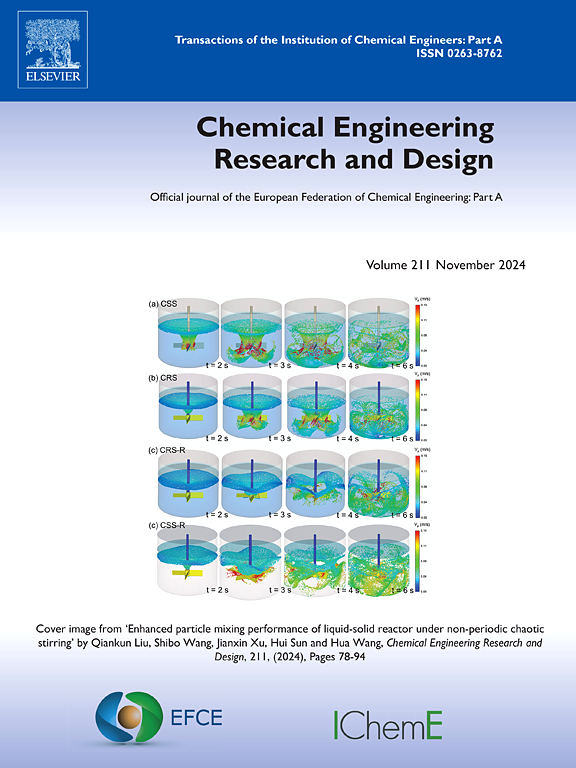Developing an integrated and collaborated evaluation index system for crude oil supply chains: A case study from China
IF 3.7
3区 工程技术
Q2 ENGINEERING, CHEMICAL
引用次数: 0
Abstract
The crude oil supply chain involves production, transportation, refining, marketing, storage and trade, characterized by numerous interconnected links and complex interrelationships. Enhancing the overall value of crude oil supply chains depends on the coordinated development of their upper, middle and lower reaches. However, the absence of a scientific and objective evaluation index system for collaborative development within the crude oil industry precludes identification of weak links that require improvement, thereby impeding decision-making in supply chain development. This study aims to develop an integrated and coordinated development evaluation index system for crude oil supply chains, providing a crucial reference framework for scientific evaluation, guidance, and assessment of crude oil supply chains. Taking China's crude oil supply chain as a case study, this research analyzes the current state of crude oil supply chain research and employs the 5 dimensions of SCOR as the primary evaluation index to examine production, transportation, refining, marketing, storage, and trading. An evaluation index system for integrated and coordinated development of the crude oil supply chain is presented, followed by the development of an evaluation model combining the combination weighting method with the TOPSIS approach. The index system and model established in this study are applied to PetroChina. The findings indicate that PetroChina achieved the highest integration and coordination level in 2021, with a score of 0.578, attributed to optimal supply chain efficiency; conversely, the integration coordination degree in 2017 was subpar, with a score of only 0.468, primarily due to the supply chain's lack of responsiveness. This evaluation index system and model offer a comprehensive assessment of the development in each link and aspect within the supply chain, which can intuitively reflect the weak points of the supply chain and provide essential theoretical support for integrated and coordinated development of PetroChina.
开发原油供应链综合协同评价指标体系:中国案例研究
原油供应链涉及生产、运输、炼油、营销、储存和贸易,其特点是相互关联的环节众多,相互关系复杂。提升原油供应链的整体价值,有赖于其上、中、下游的协调发展。然而,由于缺乏科学客观的原油行业协同发展评价指标体系,无法识别需要改进的薄弱环节,从而阻碍了供应链发展的决策。本研究旨在建立原油供应链综合协同发展评价指标体系,为科学评价、指导和评估原油供应链提供重要的参考框架。本研究以中国原油供应链为例,分析了原油供应链的研究现状,并以 SCOR 的 5 个维度为主要评价指标,对生产、运输、炼化、销售、仓储和贸易进行了研究。提出了原油供应链综合协调发展的评价指标体系,并结合组合权重法和 TOPSIS 方法建立了评价模型。本研究建立的指标体系和模型适用于中国石油。研究结果表明,中国石油在 2021 年实现了最高的整合协调水平,得分为 0.578,这归功于最佳的供应链效率;相反,2017 年的整合协调程度不高,得分为 0.468,主要原因是供应链缺乏响应能力。该评价指标体系和模型对供应链内部各环节、各方面的发展情况进行了综合评价,能够直观地反映出供应链的薄弱环节,为中国石油一体化协调发展提供了必要的理论支撑。
本文章由计算机程序翻译,如有差异,请以英文原文为准。
求助全文
约1分钟内获得全文
求助全文
来源期刊

Chemical Engineering Research & Design
工程技术-工程:化工
CiteScore
6.10
自引率
7.70%
发文量
623
审稿时长
42 days
期刊介绍:
ChERD aims to be the principal international journal for publication of high quality, original papers in chemical engineering.
Papers showing how research results can be used in chemical engineering design, and accounts of experimental or theoretical research work bringing new perspectives to established principles, highlighting unsolved problems or indicating directions for future research, are particularly welcome. Contributions that deal with new developments in plant or processes and that can be given quantitative expression are encouraged. The journal is especially interested in papers that extend the boundaries of traditional chemical engineering.
 求助内容:
求助内容: 应助结果提醒方式:
应助结果提醒方式:


